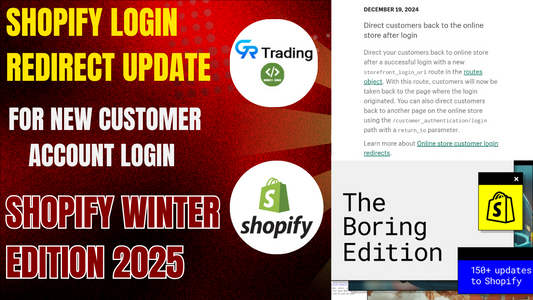Shopify offers two types of customer accounts: the New Customer Accounts and the older Legacy Accounts (previously called Classic Accounts). Although Legacy Accounts retain their original functionality, Shopify is gradually phasing them out in favor of the new Customer Accounts.
A custom app is an excellent way to overcome these limitations and ensure your business continues to thrive.
If you’re interested in using a custom app to enhance your customer data collection, feel free to contact us Or go to our Custom App Product.
Which Shopify Customer Account Is Right for You?
Choose New Customer Accounts if:
- You prioritize a simplified login experience for your customers.
- Your store does not require additional customer data collection beyond the basics (email and OTP).
Stick with Legacy Accounts if:
- You need advanced customization and the ability to collect additional data.
- Your business heavily relies on modifying Liquid files for tailored customer experiences.
Key Differences Between New and Legacy Customer Accounts
Features |
New Customer Account |
Legacy Customer Accounts |
|---|---|---|
| Hosting | Hosted by Shopify & no customization allowed | Embedded in Shopify theme & customization allowed |
| Login Method | Customers log in via email & otp, No passwords required | Customers log in using email and password |
| Customization | Limited to Shopify’s design | Fully customizable using Liquid, CSS, and JavaScript |
| Security | More secure with passwordless login and email-based access | Traditional email-password system, less secure overall |
| Support for Apps | Limited compatibility with some third-party apps | Wider compatibility with apps designed for legacy accounts |
| Scalability |
Future-proofed for Shopify updates and scaling need |
May face compatibility issues with new Shopify features |
Pros and Cons of New Customer Accounts
Pros:
Simplified Login Experience
- Customers no longer need to remember passwords; they can log in using their email and an OTP (One-Time Password).
- The process is faster and reduces friction, leading to a smoother customer experience.
Improved Security
- Password-less logins reduce the risk of account hacking and forgotten credentials, enhancing overall security.
Effortless Setup
- No need for store owners to customize Liquid files, simplifying store management.
Cons:
Limited Customization
- New Customer Accounts do not allow Liquid file customization, preventing store owners from collecting additional data like business type, website URLs, or preferences.
No Password Option
- While OTP-based login simplifies the process, some customers may prefer a traditional email-and-password login for convenience and familiarity.
Mandatory OTP
- Some customers may find the OTP system inconvenient or less familiar than traditional email-and-password logins.
Pros and Cons of Classic Customer Accounts
Pros:
Customization Potential
- With Legacy Accounts, you can customize the Liquid files to add fields for collecting additional customer information.
- Useful for businesses that need more than basic customer details, such as store owners, agencies, or B2B platforms.
Traditional Login System
- Customers create an account by providing a first name, last name, email, and password.
- Familiar for users who prefer conventional login methods.
Enhanced Data Collection
- Useful for B2B businesses or those requiring more detailed customer profiles.
- Custom fields can store specific customer information in the Shopify admin.
Cons:
Outdated User Experience
- The multi-step account creation process can feel cumbersome compared to modern, streamlined methods.
- Requires customers to remember passwords, leading to potential login issues.
Security Risks
- Password-based logins are more vulnerable to hacking or breaches compared to password-less systems.


